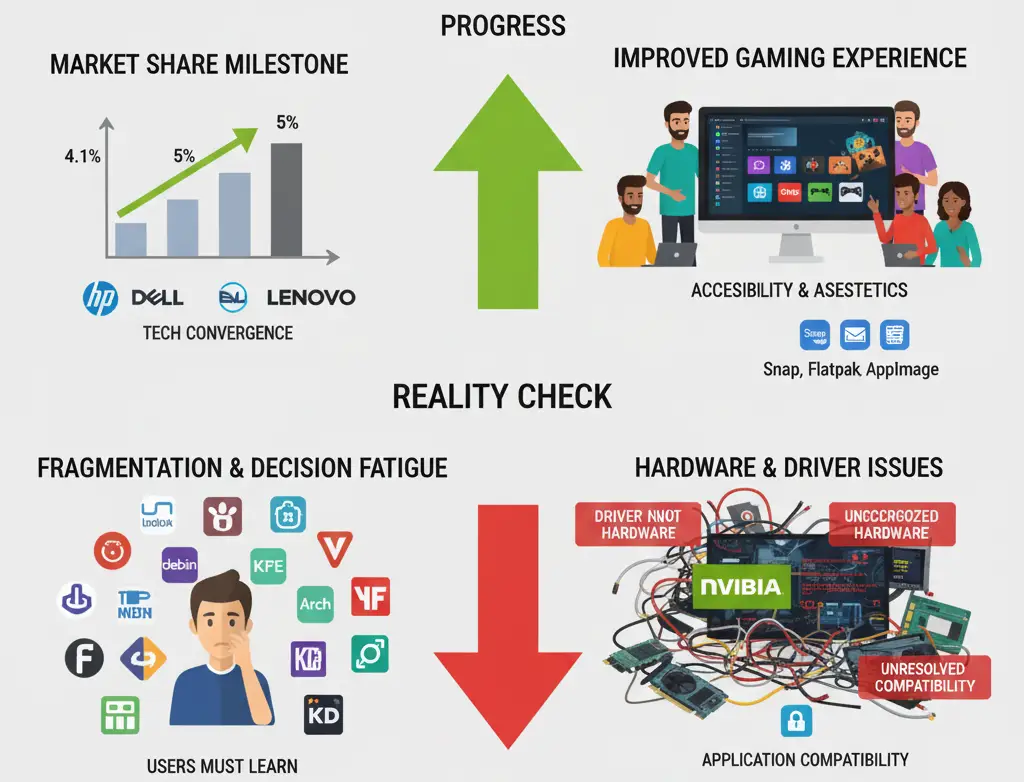
The Linux Desktop in 2025: Progress, Persistent Challenges, and Reality Check

Introduction: The State of Linux in 2025
For decades, tech communities have debated the “Year of the Linux Desktop.” The phrase symbolized the idea that Linux would eventually challenge Windows and macOS for dominance on personal computers.
As of 2025, that year has not come. Yet Linux has achieved something more meaningful: it has matured into a stable, reliable, and secure desktop operating system with a steadily growing user base. Millions of users worldwide now run Linux daily for development, business, education, and even gaming.
This article takes a deep look at Linux’s strengths, weaknesses, adoption trends, and the global picture of Linux desktop usage in 2025.
Linux Desktop Adoption in 2025
The global desktop operating system market remains dominated by Windows and macOS, but Linux has been making quiet progress.
- United States: Linux desktop share crossed 5% in June 2025 for the first time in history.
- Worldwide: Linux accounts for about 4% of all desktops, up from 2.7% in 2022.
- India & Germany: Adoption rates are notably higher than the global average.
This growth is driven by:
- Gaming on Linux – Valve’s Steam Deck and Proton compatibility layer have made Linux gaming mainstream.
- Linux-first laptops – Companies like Framework and System76 sell devices preloaded with Linux.
- Enterprise influence – Tech giants like Google and Amazon rely heavily on Linux, normalizing its use among employees.
Top 10 Countries by Linux Desktop Usage (2025)
Stat Counter and regional market share reports show Linux adoption varies significantly by country. Below is a table of Linux usage where reliable data is available:
Rank | Country | Linux Desktop Market Share (2025) | Notes |
1 | India | ~9.3% | One of the highest Linux adoption rates globally. |
2 | Germany | ~5.4% | Strong open-source culture drives usage. |
3 | United States | ~5.0% | Crossed 5% in mid-2025, an all-time high. |
4 | Cuba | ~4.9% (est.) | Government initiatives favor open-source solutions. |
5 | Russia | ~4.8% (est.) | Increased adoption due to reduced reliance on Western software. |
6 | Czech Republic | ~4.7% (est.) | Popular among universities and developers. |
7 | Poland | ~4.6% (est.) | Growing student and IT community adoption. |
8 | Brazil | ~4.5% (est.) | Community-driven Linux adoption across schools and enterprises. |
9 | France | ~4.4% (est.) | Higher adoption compared to many Western countries. |
10 | Worldwide Average | ~4.0% | Global adoption rate as of mid-2025. |
Note: Some values are approximations based on StatCounter trends and regional reports.
Debunking the Myth: Is Linux Still Buggy?
The “Linux is buggy” narrative is outdated. In 2025, modern Linux distributions rival or surpass Windows and macOS in stability.
Why Linux Is Stable Today
- Mature distros: Ubuntu 24.04 LTS, Fedora 40, Pop!_OS, and Linux Mint provide polished, reliable experiences.
- Refined desktop environments: GNOME and KDE Plasma are smooth, responsive, and user-friendly.
- Strong kernel testing: The Linux kernel is one of the most scrutinized software projects worldwide.
Why People Still Think Linux Is Buggy
- Fragmentation – Hundreds of distributions mean inconsistent user experiences.
- DIY customizations – Users can break systems by misconfiguring software.
- Hardware lottery – Compatibility issues arise when vendors don’t prioritize Linux drivers.
The Real Weakness: Hardware Drivers
While Linux itself is stable, driver support remains a major challenge.
- NVIDIA GPUs: Proprietary drivers are powerful but hard to install and maintain. Updates sometimes cause black screens or crashes.
- AMD GPUs: Offer smoother support via open-source drivers integrated into the Linux kernel.
- Wi-Fi & Bluetooth: Support for newer standards like Wi-Fi 6E/7 often lags.
Laptops: Power management and sleep/wake issues remain on some hardware
Other Challenges Beyond Drivers
- Software Availability – Many professional apps (e.g., Adobe Creative Suite, Microsoft Office desktop) are unavailable.
- Gaming Limitations – Proton enables thousands of titles, but anti-cheat restrictions block popular games like Valorant and Fortnite.
- Learning Curve – GUI tools have improved, but advanced troubleshooting often requires command-line knowledge.
Ecosystem Lock-In – Unlike Apple and Microsoft, Linux lacks tightly integrated cloud and device ecosystems
Where Linux Excels in 2025
Despite these challenges, Linux offers significant advantages:
- Performance: Runs smoothly on older or low-spec machines.
- Security & Privacy: Minimal telemetry, fewer malware threats.
- Customization: Endless desktop personalization.
- Wayland adoption: Now default in most distros, delivering modern graphics handling.
- Gaming Revolution: Steam Deck and Proton have made Linux a legitimate gaming platform.
Who Benefits the Most from Linux in 2025?
- Developers & Sysadmins: Seamless server integration, container tools, and programming environments.
- Privacy-focused users: No telemetry or forced accounts.
- Students & educators: Cost-effective, open-source learning tools.
- Gamers (with AMD GPUs): Access to thousands of Steam titles.
- Budget-conscious users: Revives hardware that Windows 11 can’t support.
Conclusion: Linux’s Real Place in 2025
The “Year of the Linux Desktop” may never happen in the sense of dominating the market. But in 2025, Linux has already succeeded by:
- Providing a stable, private, and secure computing environment.
- Offering better performance on old hardware.
- Powering modern gaming experiences once thought impossible.
- Serving developers, students, and privacy advocates better than any other OS.
Linux does not need to replace Windows or macOS to be successful. Its role is to give users freedom, control, and choice in an increasingly locked-down tech world.
For those who value privacy, customization, or performance on older machines, Linux in 2025 is more than ready for daily use.






Your point of view caught my eye and was very interesting. Thanks. I have a question for you. https://accounts.binance.info/ph/register?ref=IU36GZC4